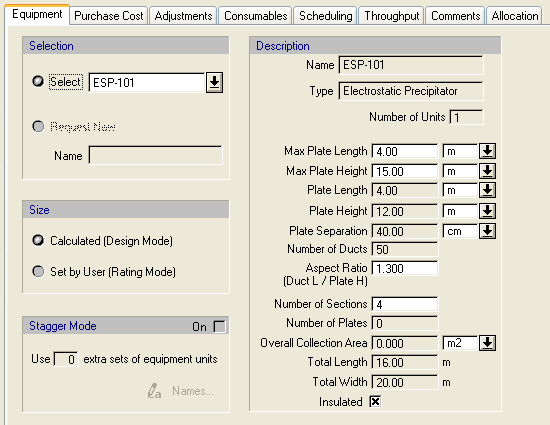

The following table shows the meaning of the variables appearing in this tab, as well as their default values and their generally acceptable range. Note that due to the manner by which the variables are used by the sizing and costing equations, the range of acceptable values may be further reduced.
|
Variable |
Default Value |
Range |
|
|
||
|
◙ Plate Length |
4.0 m |
Positive |
|
◙ Plate Height |
12.0 m |
Positive |
|
◙ Max. Plate Length |
4.0 m |
Positive |
|
◙ Max. Plate Height |
15.0 m |
Positive |
|
◙ Plate Separation |
40.0 cm |
Positive |
|
◙ Number of Ducts |
50 |
Positive |
|
○ Aspect Ratio |
1.3 |
Positive |
|
○ Number of Sections
|
4 |
Positive |
|
◙ Number of Plates |
0 |
Positive |
|
● Overall Collection Area |
0.00 m2 |
Positive |
|
● Total Length |
16.0 m2 |
Positive |
|
● Total Width |
20 m2 |
Positive |
|
○ Insulated |
Yes |
Yes/No |
Symbol Key: ○ User-specified value (always input); ● Calculated value (always output); ◙ Sometimes input, sometimes output
In Design Mode, the use specifies the Max Plate Length and the Max Plate Height and the system computes the Plate Height, Plate Length, Plate Separation and the Number of Ducts.
In Rating mode, the user specifies the plate length, plate height, plate separation, number of ducts, number of plates and the number of units.
For more information, see Electrostatic Precipitation: Modeling Calculations.
The equipment purchase cost is based on the total collection area. By default it is calculated by the programs built-in model for a ESP.
For more information on this equipment, see Electrostatic Precipitator.
For information on the left-hand side variables and options, see Equipment Data Dialog: Equipment tab.